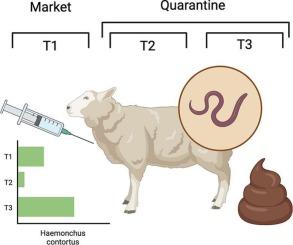Ramming the parasites: Evaluation of quarantine procedures against Haemonchus contortus at sheep markets in Sweden
IF 1.4
Q3 PARASITOLOGY
Veterinary parasitology, regional studies and reports
Pub Date : 2024-10-05
DOI:10.1016/j.vprsr.2024.101125
引用次数: 0
Abstract
In Sweden, it is recommended to treat rams at sheep markets with ivermectin and then keep them in quarantine to minimise the risk of transmission of Haemonchus contortus between farms. The aim of this study was to evaluate the effectiveness of this practise. Accordingly the gastrointestinal parasite status of 50 rams purchased at two sheep markets in central Sweden in autumn 2019 was investigated using faecal samples collected on the day of sale (test 1), 12 ± 3 days after ivermectin injection (test 2, in quarantine) and a few months later before inclusion in the new flocks (test 3). We used both traditional diagnostic methods (i.e. identification of nematode eggs in faeces or larvae in cultures when H. contortus eggs could not be identified) and a molecular test based on the digital droplet PCR platform to further identify positive samples. In test 1, conducted in autumn, 40 % of rams were FEC-positive, but only 12 % (six rams) were infected with H. contortus according to conventional routine diagnostics. In test 2, 8 % (four rams) were FEC-positive, including one with 1050 eggs, 90 % of which were identified as H. contortus. This ram was therefore returned to the supplier. However, ivermectin was found to be effective when this animal and a group of lambs from the same farm were treated and tested again. Test 3 was performed on 44 of the same rams (in addition to the returned ram, two rams died in quarantine and the samples from three rams were never provided by the owners). The proportion of FEC-positive animals was 42 %, with an even higher proportion (27 %) of animals being H. contortus-positive than in test 1. The corresponding results for tests 1, 2 and 3 with the ddPCR assay were 18 %, 4 % and 76 %, respectively. This study demonstrates the superiority of DNA detection over microscopy, which is the mainstay in most diagnostic laboratories. Although the combined results confirm that H. contortus survived quarantine in two rams, in the other cases it is not clear whether the spring infection rates are due to re-emergence of persistent larvae from quarantine or reinfection on the new farm. These results suggest not only that we should recommend that sheep farmers use a more sensitive molecular test when purchasing and introducing new animals to their flock, but also that the reliability of injectable ivermectin as a quarantine treatment for removal of adult and larval stages needs further investigation.

撞击寄生虫:对瑞典羊肉市场上防治口蹄疫检疫程序的评估
瑞典建议在绵羊市场上用伊维菌素治疗公羊,然后对其进行检疫,以最大限度地降低血吸虫在牧场之间传播的风险。本研究旨在评估这一做法的有效性。因此,我们使用销售当天(测试 1)、注射伊维菌素后 12 ± 3 天(测试 2,检疫中)和几个月后加入新羊群前(测试 3)采集的粪便样本,对 2019 年秋季在瑞典中部两个羊市场购买的 50 只公羊的胃肠道寄生虫状况进行了调查。我们采用了传统的诊断方法(即在无法识别线虫卵的情况下,鉴定粪便中的线虫卵或培养物中的幼虫)和基于数字液滴 PCR 平台的分子检测方法来进一步鉴定阳性样本。在秋季进行的试验 1 中,40% 的公羊 FEC 阳性,但根据传统的常规诊断方法,只有 12%(6 只公羊)感染了传染性软疣。在试验 2 中,8% 的公羊(4 只)FEC 呈阳性,其中一只公羊的卵数为 1050 个,其中 90% 被鉴定为传染性软疣梭菌。因此,这只公羊被退回给供应商。然而,在对这只公羊和来自同一农场的一组羔羊进行治疗和再次检测时,发现伊维菌素是有效的。对 44 只相同的公羊进行了第 3 次测试(除退回的公羊外,还有两只公羊在检疫期间死亡,有三只公羊的样本主人从未提供)。检测 1、2 和 3 的 ddPCR 检测结果分别为 18%、4% 和 76%。这项研究表明,DNA 检测优于显微镜检测,而显微镜检测是大多数诊断实验室的主流检测方法。虽然综合结果证实有两只公羊的检疫后感染了霍乱弧菌,但其他病例的春季感染率是由于检疫后持续存在的幼虫再次出现还是由于新猪场的再次感染尚不清楚。这些结果表明,我们不仅应该建议养羊户在购买和引进新动物时使用更灵敏的分子检测方法,而且还需要进一步研究注射伊维菌素作为检疫治疗方法清除成虫和幼虫的可靠性。
本文章由计算机程序翻译,如有差异,请以英文原文为准。
求助全文
约1分钟内获得全文
求助全文
来源期刊
CiteScore
2.90
自引率
7.10%
发文量
126
审稿时长
97 days
期刊介绍:
Veterinary Parasitology: Regional Studies and Reports focuses on aspects of veterinary parasitology that are of regional concern, which is especially important in this era of climate change and the rapid and often unconstrained travel of people and animals. Relative to regions, this journal will accept papers of the highest quality dealing with all aspects of disease prevention, pathology, treatment, epidemiology, and control of parasites within the field of veterinary medicine. Also, case reports will be considered as they add to information related to local disease and its control; such papers must be concise and represent appropriate medical intervention. Papers on veterinary parasitology from wildlife species are acceptable, but only if they relate to the practice of veterinary medicine. Studies on vector-borne bacterial and viral agents are suitable, but only if the paper deals with vector transmission of these organisms to domesticated animals. Studies dealing with parasite control by means of natural products, both in vivo and in vitro, are more suited for one of the many journals that now specialize in papers of this type. However, due to the regional nature of much of this research, submissions may be considered based upon a case being made by the author(s) to the Editor. Circumstances relating to animal experimentation must meet the International Guiding Principles for Biomedical Research Involving Animals as issued by the Council for International Organizations of Medical Sciences (obtainable from: Executive Secretary C.I.O.M.S., c/o W.H.O., Via Appia, CH-1211 Geneva 27, Switzerland).

 求助内容:
求助内容: 应助结果提醒方式:
应助结果提醒方式:


